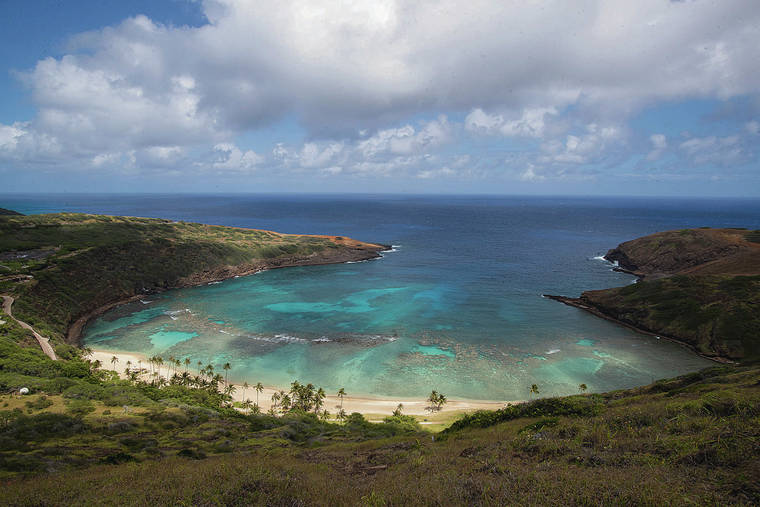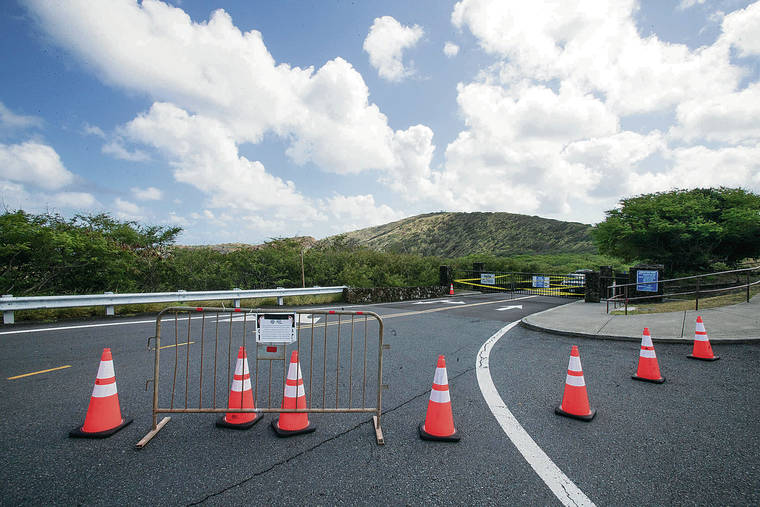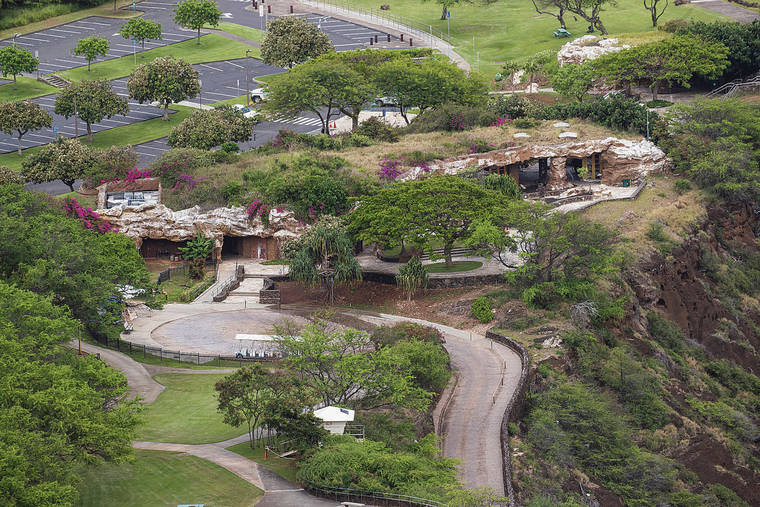Hawaii researchers are studying whether human activity has a negative impact on fish and the reef at Hanauma Bay

CINDY ELLEN RUSSELL / CRUSSELL@STARADVERTISER.COM
Hanauma Bay looked pristine and peaceful Tuesday.

CINDY ELLEN RUSSELL / CRUSSELL@STARADVERTISER.COM
The entrance to the bay was coned off Tuesday as the nature preserve remained closed because of the COVID-19 pandemic.

CINDY ELLEN RUSSELL / CRUSSELL@STARADVERTISER.COM
The visitors center and parking lot at the Hanauma Bay Nature Preserve remain closed because of the COVID-19 pandemic.



Sheltering from the wind beside the lifeguard station on the beach at the City and County of Honolulu’s Hanauma Bay Nature Preserve, Ku‘ulei Rodgers took a solitary lunch break and described a rare sight: There were only five people, including her, in the water and on the beach.
It was Tuesday, the one day a week that the bay has historically been closed for maintenance and to give the marine ecosystem a breather from the 3,000 people a day who thronged its sands and inshore waters; but since March 16 the preserve has been closed to the public every day due to the new coronavirus, which easily spreads in crowds. The closure is scheduled to continue through the end of May.
Besides Rodgers, the only human beings within the 101-acre arena of sea, cliffs and sandy beach were fellow researchers from the University of Hawaii’s Hawaii Institute of Marine Biology’s Coral Reef Ecology Lab, which she leads as principal investigator.
“I can see Liz Madin, one of our scientists, sitting on a rocky ledge above the Toilet Bowl (a wave-washed pool near the mouth of the bay), where her (submerged) camera is looking at fish behavior, and all the way on the other side of the bay, in the channel, technician Andrew Graham and intern Matt Stefanak are doing fish-distance studies,” Rodgers said into her cellphone over the wind’s roar.
The fish-distance project measures how close fish will let snorkelers approach before they flee. It is one of several new studies the lab has designed and launched since the shutdown. The idea is to observe and measure how the reef ecosystem fares in the absence of human activity, said Rodgers, who has been studying the coral reef ecosystem at Hanauma Bay since 1992.
“It was horrible what was happening, and we were afraid, of course,” she said of the third week in March, when COVID-19 was spreading in Hawaii and her staff had shut their lab down and were working from home.
Don't miss out on what's happening!
Stay in touch with breaking news, as it happens, conveniently in your email inbox. It's FREE!
“But when we heard about the Hanauma Bay closure, we thought, this is the perfect opportunity for us because before, we could only look at the difference between Tuesdays and the rest of the time, when visitors were there.”
Now, she said, they had a good stretch of time to see “if human activity is really a negative impact” by measuring and observing fish behavior, reef sedimentation and water turbidity, and coral larvae without people around, and then comparing the data with data they will collect in ongoing studies after the people return.
Until then, Rodgers said, the scientists could talk story but draw no conclusions.
Some of the things they’re looking for include whether there are bigger fish coming in closer to shore, or different species of fish appearing, than when people were present; whether fish seem more afraid of approaching people or less afraid; how their foraging, grazing, hunting and interactions with other fish might change; and whether a significant cause of sedimentation on the reef is sand kicked up by snorkelers’ fins, as opposed to wind and wave action and runoff from land.
The scouring effect of sand on the reef will kill coral larvae, known as recruits, Rodgers said.
One of the new studies underway is a coral recruitment survey, “looking up even the tiniest baby corals, less than half a millimeter, which you can’t see with the naked eye, using fluorescent light,” said Sarah Severino, who co-authored a 2018-2019 Hanauma Bay biological carrying capacity study with Rodgers and has worked on coral bleaching studies.
Because the coral recruits contain a green fluorescent pigment, “like melanin in humans, they become visible if a blue light is shone on them,” Severino said. “We’ll be able to tell how many have been recruited (attach to the reef), how much they grow, and when people come back we’ll see if there’s a change.”
Even pre-coronavirus, there had been findings of direct human harm.
Last year the lab studied how much breakage of coral occurred in each sector of Hanauma Bay, from the rougher, offshore waters where only 2% of tourists venture, to the inshore shallow waters where 98% of the 500 visitors admitted at intervals throughout the day float, shoulder-to-shoulder.
“It correlated perfectly, with high breakage in sectors being heavily used,” Rodgers said.
It’s been observed that about 50% of visitors go into the shallow Keyhole Lagoon in the center of the bay, “and that also had the most sediment on the reef.”
Rodgers did share a few anecdotal observations.
“While we don’t have enough data yet, we’re seeing some of the bigger fish coming a little closer inshore, and we’re seeing monk seals every time we come, when we used to only see them sometimes.”
And while a study last year found that water clarity in Hanauma Bay was 30% greater on Tuesdays than the other six days of the week, now it looks “even better,” she said, but they wouldn’t know for certain about water quality until they’ve measured suspended sediments over time; next week, she added, a water quality scientist will start taking samples to test for pollutants.
Rodgers added that for the scientists it’s been easier to conduct research, such as installing video cameras and sediment traps on the reefs, without interference from snorkelers.
“Before, because there were so many people, they would kick the video cameras,” Rodgers said. “And we’ve had people remove our sediment traps and bring them to shore, saying they found this rubbish on the reef — trying to be helpful.”
It would take a while to set up the fixed, stereovideo cameras, Severino said, due to surges and tides in the bay. The goal is to have them in place, recording fish behavior throughout the different sectors of the bay by the last two weeks in May, and to continue recording when people return for at least the first two weeks in June.
But for a month they’ve been conducting behavior analyses with the fish- distance studies.
“As we approach a fish, we determine how close we can get before it turns away, and we study its behavior as it flees,” Severino said. “Does it go into a crevice or go to a new foraging spot?”
On Tuesday, she said, the researchers also set up Gopro cameras to see how long the herds of herbivorous fish are foraging and what they are foraging on when they aren’t being pursued by excited snorkelers.
Still, Severino and Rod- gers said that while it was invaluable to be able to measure the impacts of snorkelers on the reef ecosystem, as separate from the sedimentation caused by stormwater runoff and coral bleaching due to warmer ocean temperatures and acidification, people need to take action to reduce our collective greenhouse gas emissions.
“As horrible as this pandemic has been,” said Severino, noting that she was writing up a report on a coral bleaching survey taken over the summer, “it’s caused a lot of us to slow down and really think about our everyday decisions and how that impacts the earth.”
The main thing affecting coral reefs, Rodgers agreed, is climate change, and “the best way to protect the reef is to reduce your carbon.”




